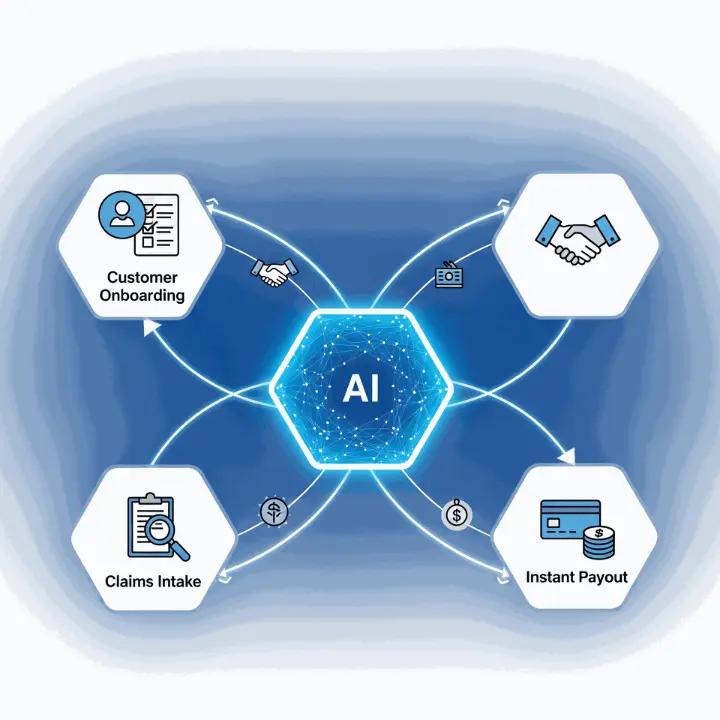Executive Summary
Lemonade stands as a seminal case study in the application of agentic AI to a legacy industry. By designing a digital-first insurance model around autonomous conversational agents Maya for customer acquisition and AI Jim for claims management the company has fundamentally rewired the operational DNA of insurance.
This approach has not only created a more efficient, low-cost distribution model but has also redefined the customer experience, offering speed and simplicity that are virtually unmatched by traditional insurers. As of Q2 2025, Lemonade's publicly reported metrics underscore the power of this strategy, with a high degree of operational automation translating into tangible financial benefits and a scalable growth trajectory.
This in-depth analysis explores the strategic, technical, and financial dimensions of Lemonade's AI-driven model, offering a comprehensive look at its impact, advantages, and inherent challenges.
1. The Challenge: Reimagining a Legacy Value Chain
The traditional insurance industry is burdened by operational inefficiencies, including a heavy reliance on manual underwriting, human-driven claims adjustment, and extensive paperwork.
This leads to high loss-adjustment expenses (LAE), slow payouts, and a customer experience that often feels adversarial. Lemonade was founded to solve this problem by leveraging a "digital-first" philosophy.
The core thesis was to replace the entire legacy value chain—from brokers and phone-based intake to human adjusters—with a seamless, data-driven platform. The goal was to eliminate friction and costs, thereby making insurance more accessible, affordable, and trustworthy.
2. The Agentic Architecture: Maya, AI Jim, and the "Customer Cortex"
Lemonade’s proprietary platform, the "Customer Cortex," is the technical backbone of its operations. The most visible components are its two AI agents, Maya and AI Jim, which represent a sophisticated blend of conversational UI, machine learning, and rules-based logic.
i. Maya
The AI Onboarding Agent Maya's role extends beyond a simple chatbot. It is a full-stack underwriting agent that guides prospective customers through a conversational flow. Instead of a static form, Maya asks a series of questions in a user-friendly, one-at-a-time format. In the background, this agent is running multiple machine learning models to assess risk and provide a dynamic, personalized quote.
This process is highly efficient; over 90% of Lemonade's policies are now sold through bots, significantly lowering the cost of customer acquisition compared to a broker-reliant model. The conversational design is a strategic choice, as it helps collect a richer dataset including user behavior and response times that further refines the underwriting models.

ii. AI Jim
The Claims Automation Manager AI Jim is Lemonade's claims agent, a sophisticated system that has evolved from a simple intake bot to a senior automation manager. When a claim is filed, AI Jim receives the First Notice of Loss (FNOL), often a short video or text from the customer. The system then performs a multi-layered analysis:
- Conversational Triage: It asks clarifying questions and guides the customer through the process.
- Rules-Based Checks: It immediately verifies the customer’s policy and coverage details.
- Fraud & Severity Prediction: Using advanced machine learning models, it analyzes the claim for potential fraud and assesses its complexity. Lemonade has publicly discussed how its AI can analyze non-verbal cues from video submissions, a data point largely unavailable to traditional insurers.
- Automated Adjudication: For straightforward, low-value claims that pass all checks, AI Jim can issue a payout in seconds. This speed has become a key brand differentiator.
- Human Escalation: For complex, high-value, or questionable claims, AI Jim automatically routes the case to a human expert. This hybrid approach ensures that the vast majority of claims are handled with speed and efficiency, while human oversight is reserved for where it's most needed. As of Q2 2025, Lemonade reported that approximately 55% of claims are processed with end-to-end automation.
3. Financial and Operational Outcomes: A Deep Dive
Lemonade's AI-first model has produced a number of quantifiable financial and operational benefits:
- Top-Line Growth & Operational Leverage: The company's in-force premium (IFP) has grown at a rapid pace, surpassing $1 billion by Q2 2025. This growth is a direct result of the scalable, low-cost model, which allows Lemonade to acquire customers more efficiently than competitors. The company's Q2 2025 results showed a 35% increase in revenue year-over-year. A key indicator of operational leverage is that while IFP grew 29% in the same period, operating expenses (excluding growth spending) declined by 2%. This demonstrates that the company is getting more efficient as it scales.
- Improved Profitability & Loss Ratio: A central metric for any insurer is the gross loss ratio, which measures the proportion of premiums paid out as claims. Lemonade's AI-driven underwriting and claims processing have contributed to a significant improvement in this metric. The trailing twelve-month loss ratio improved to 70% in Q2 2025, a 12-point improvement from the previous year and a signal that the company is getting better at both pricing risk and managing claims costs.
- Path to Profitability: While still a growth-stage company, Lemonade has made notable strides toward profitability. The company achieved its first full year of positive adjusted free cash flow in 2024, a year ahead of its initial plan. This was followed by another positive adjusted free cash flow quarter in Q2 2025, a key milestone that signals a maturing business model.
- Customer-Centric Metrics: Beyond the financial numbers, the AI model has translated into superior customer experience metrics. Lemonade consistently reports a high Net Promoter Score (NPS), particularly for customers who interact with the AI agents. This positive feedback loop of a fast, user-friendly experience leads to higher retention rates and a stronger brand reputation.

4. Competitive Landscape and Regulatory Challenges
Lemonade’s model presents distinct competitive advantages but also faces significant risks.
- Competitive Advantages: The most significant advantage is its data flywheel. Every interaction from a policy quote to a claims video creates proprietary data that improves the AI models, leading to better risk assessment, fraud detection, and customer experience. This allows Lemonade to offer more precise pricing and continue to refine its operational efficiency. Its digital-first architecture gives it a speed and agility that legacy insurers, with their siloed systems, find difficult to replicate.
- Disadvantages & Competition: However, Lemonade's early-mover advantage is diminishing as larger competitors and other insurtech startups are rapidly adopting similar AI technologies. Legacy insurers, with their immense capital reserves and vast historical datasets, pose a significant threat. Companies like GEICO and Allstate are already using AI for automated damage assessment and customer communication, eroding the exclusivity of Lemonade's technological edge.
- Regulatory Scrutiny: The use of AI in insurance introduces significant regulatory and ethical risks. Automated underwriting and claims decisions could potentially lead to algorithmic bias, unfairly impacting certain demographic groups. Regulators are increasingly focused on ensuring transparency and explainability in these models. Lemonade, and the broader industry, must navigate a complex and evolving regulatory landscape that requires robust governance, auditing, and clear communication about how AI systems make decisions.
5. Conclusion and Future Outlook
Lemonade's case demonstrates that a full-stack, AI-driven model can fundamentally transform insurance. Its success lies in using agentic AI not just as a cost-cutting tool but as a core component of its business strategy to create a more efficient, customer-centric, and scalable enterprise.
For a legacy insurer, Lemonade offers a clear blueprint for modernization. However, its journey also highlights the need for a holistic approach that balances technological innovation with sound underwriting, disciplined financial management, and a deep understanding of the regulatory environment.
The long-term success of this model will depend on Lemonade's ability to maintain its technological lead while maturing into a consistently profitable business, proving that AI can be a lever for sustainable growth and not just a tool for disruption.